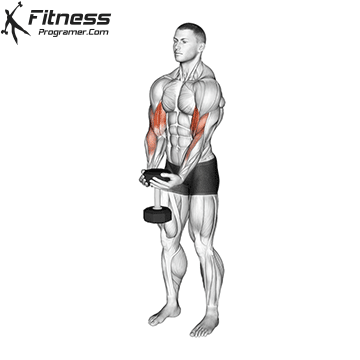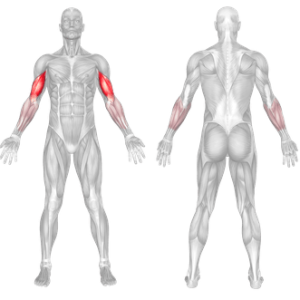Waiter Curl
A waiter curl is a type of bicep exercise that involves using a dumbbell with a unique grip to target the biceps in a different way than traditional curls. It is named “waiter curl” because the movement is somewhat reminiscent of a waiter carrying a tray, where the flat end of the dumbbell is rested on the palm of your hand.
The waiter curl differs from other bicep exercises in that it eliminates the need for a traditional grip, which can reduce forearm and grip fatigue, allowing you to target the biceps more directly. It primarily works the biceps brachii, with a particular emphasis on the long (outer) head of the biceps
How to do:

- Stand up straight with your feet about hip-width apart.
- Hold a dumbbell with both hands, allowing the dumbbell to rest on your palms, and avoid gripping it with your fingers.
- Start with your arms fully extended, holding the dumbbell in front of you at thigh level.
- The top of the dumbbell should be facing straight up.
- Keeping your back straight and your shoulder blades pulled back, focus on using only your biceps to curl the weight towards your chest.
- Ensure that the top of the dumbbell remains facing upward throughout the entire repetition.
- Slowly lower the dumbbell back to the starting position to complete one repetition.
Gradual Progression: Beginners can start with a manageable weight and gradually increase it as they become more comfortable with the exercise. This allows for a gradual progression in both strength and muscle development.
Benefits of the Waiter Curl
Isolation of the Biceps: Isolating the biceps is one of the key benefits of the waiter curl. By cradling the dumbbell in your palms and removing the need for a traditional grip, this exercise minimizes forearm and grip involvement, allowing you to focus solely on working the biceps. This isolation can lead to a more effective bicep workout, helping to build strength and size in this muscle group. If you’re looking to specifically target and develop your biceps, the waiter curl can be a valuable addition to your workout routine.
Beginner-Friendly: The waiter curl’s movement pattern is relatively straightforward. Holding the dumbbell with a unique grip, you perform a controlled curling motion, focusing on your biceps. The elimination of a traditional grip means less strain on the forearm and wrist, which can be beneficial for beginners who may not have developed strong forearm muscles yet.
Adding variety to your arm training routine can lead to more balanced and comprehensive development. While traditional curls have their place, incorporating the waiter curl ensures that you’re targeting all aspects of your biceps for a more well-rounded look.
Waiter Curl Muscles Worked

The waiter curl primarily targets the biceps brachii, with a specific emphasis on the long head of the biceps. Here’s a breakdown of the muscles worked during the waiter curl:
- Biceps Brachii: The biceps brachii is the primary muscle targeted by the waiter curl. It consists of two heads: the long head and the short head. The waiter curl, with its unique grip and movement pattern, places a strong emphasis on the long (outer) head of the biceps. This emphasis can help you achieve a better bicep peak and overall bicep development.
- Brachialis: The brachialis is a muscle located beneath the biceps brachii. It’s one of the largest elbow flexors responsible for forearm flexion. During the waiter curl, the brachialis also plays a role in flexing the elbow joint, contributing to the overall effectiveness of the exercise.
- Forearm Flexors: While the primary focus of the waiter curl is on the biceps, the movement also activates the forearm flexor muscles. These muscles help move the forearms into a supinated position (palms facing up), which is the typical hand position during the exercise. Although the forearm flexors are not the primary target, they are involved in stabilizing and supporting the movement.
- Brachioradialis: The brachioradialis is a muscle on the forearm, and it plays a smaller role during the waiter curl compared to the biceps and brachialis. It assists in elbow flexion and forearm supination during the exercise.
